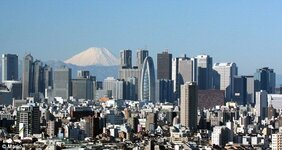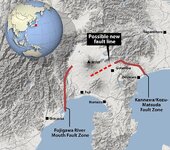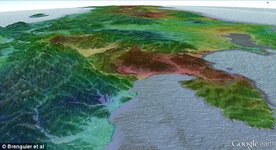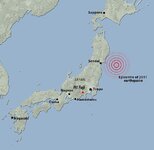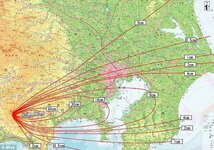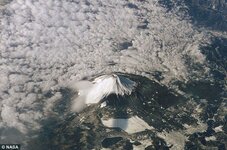DeepseekerADS
Gold Member
- Mar 3, 2013
- 14,880
- 21,733
- Detector(s) used
- CTX, Excal II, EQ800, Fisher 1260X, Tesoro Royal Sabre, Tejon, Garrett ADSIII, Carrot, Stealth 920iX, Keene A52
- Primary Interest:
- Other
Mount Fuji Is In A 'Critical State' And Could Be Ready To Blow, Researchers Say
If this were to happen, imagine the impact on the economy of Japan - and the world. When I was in Tokyo I could see the volcano in the distance....
Mount Fuji Is In A 'Critical State' And Could Be Ready To Blow, Researchers Say
The Huffington Post | By Sara Gates
Posted: 07/17/2014 6:09 pm EDT Updated: 07/19/2014 3:59 pm EDT
Mount Fuji is primed to spew.
After 307 years, the massive active volcano in Japan may be due for another eruption as a result of a buildup of pressure from the 9.0-magnitude earthquake that hit the country's eastern coast in 2011. While volcano eruptions may often be difficult to predict, a new study published by a team of French and Japanese researchers indicates that Mount Fuji is in a particularly precarious state.
"Our work does not say that the volcano will start erupting, but it does show that it's in a critical state," lead author Florent Brenguier, a researcher at the Institute of Earth Sciences in France, told The Guardian.
The team analyzed data from more than 800 seismic sensors in Japan in order to observe how volcanos react to seismic waves, which are generated by impulses such as earthquakes or explosions. By pinpointing how these waves of energy affect volcanos, researchers should be better equipped to evaluate the risk of volcanic eruptions and may even be able to help predict an eruption.
The team scrutinized "seismic noise" to build something similar to an ultrasound of the Earth's crust. What they found is that the regions with the greatest disruptions were not situated near the epicenters of earthquakes, but were instead concentrated beneath volcanic regions, particularly Mount Fuji.
Brenguier explained to The Guardian:
The volcanic regions are the ones where the fluids trapped in the rock -- boiling water, gas, liquid magma, which cause an eruption when they rise to the surface -- exert the greatest pressure. The seismic waves add to this pressure, causing even more disturbance.
While the team could not establish a cause-and-effect relationship between earthquake and volcanic activity, its findings serve as a warning for Japan to be aware of the pressure brewing beneath Mount Fuji. As Quartz notes, an eruption could spell disaster for the 8 million people in Tokyo, as well as the surrounding areas.
Earlier this year, local governments in the districts near the active volcano adopted a comprehensive evacuation plan that calls for 1.2 million people to flee their homes in case of an eruption. Residents of cities immediately surrounding Mount Fuji would be in danger of lava flow, while homes in communities further removed would be most at-risk from falling volcanic ash.
If this were to happen, imagine the impact on the economy of Japan - and the world. When I was in Tokyo I could see the volcano in the distance....
Mount Fuji Is In A 'Critical State' And Could Be Ready To Blow, Researchers Say
The Huffington Post | By Sara Gates
Posted: 07/17/2014 6:09 pm EDT Updated: 07/19/2014 3:59 pm EDT
Mount Fuji is primed to spew.
After 307 years, the massive active volcano in Japan may be due for another eruption as a result of a buildup of pressure from the 9.0-magnitude earthquake that hit the country's eastern coast in 2011. While volcano eruptions may often be difficult to predict, a new study published by a team of French and Japanese researchers indicates that Mount Fuji is in a particularly precarious state.
"Our work does not say that the volcano will start erupting, but it does show that it's in a critical state," lead author Florent Brenguier, a researcher at the Institute of Earth Sciences in France, told The Guardian.
The team analyzed data from more than 800 seismic sensors in Japan in order to observe how volcanos react to seismic waves, which are generated by impulses such as earthquakes or explosions. By pinpointing how these waves of energy affect volcanos, researchers should be better equipped to evaluate the risk of volcanic eruptions and may even be able to help predict an eruption.
The team scrutinized "seismic noise" to build something similar to an ultrasound of the Earth's crust. What they found is that the regions with the greatest disruptions were not situated near the epicenters of earthquakes, but were instead concentrated beneath volcanic regions, particularly Mount Fuji.
Brenguier explained to The Guardian:
The volcanic regions are the ones where the fluids trapped in the rock -- boiling water, gas, liquid magma, which cause an eruption when they rise to the surface -- exert the greatest pressure. The seismic waves add to this pressure, causing even more disturbance.
While the team could not establish a cause-and-effect relationship between earthquake and volcanic activity, its findings serve as a warning for Japan to be aware of the pressure brewing beneath Mount Fuji. As Quartz notes, an eruption could spell disaster for the 8 million people in Tokyo, as well as the surrounding areas.
Earlier this year, local governments in the districts near the active volcano adopted a comprehensive evacuation plan that calls for 1.2 million people to flee their homes in case of an eruption. Residents of cities immediately surrounding Mount Fuji would be in danger of lava flow, while homes in communities further removed would be most at-risk from falling volcanic ash.


